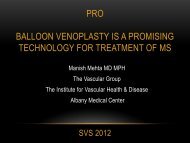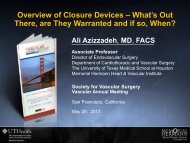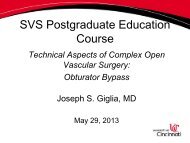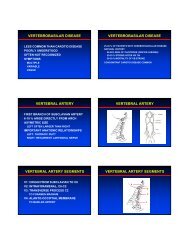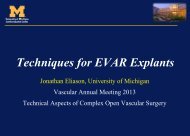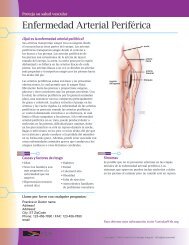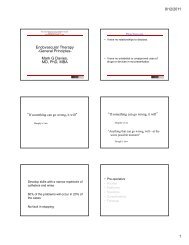RPVI Exam Vascular Physics Case Review.pdf - VascularWeb
RPVI Exam Vascular Physics Case Review.pdf - VascularWeb
RPVI Exam Vascular Physics Case Review.pdf - VascularWeb
You also want an ePaper? Increase the reach of your titles
YUMPU automatically turns print PDFs into web optimized ePapers that Google loves.
<strong>RPVI</strong> TM<br />
<strong>Exam</strong><br />
<strong>Vascular</strong> <strong>Physics</strong> <strong>Case</strong> <strong>Review</strong><br />
Frank R. Miele<br />
I have nothing to disclose!
<strong>Exam</strong> Overview: According to Outline<br />
I. Instrumentation and Ultrasound <strong>Physics</strong> (12-18%)<br />
A. Doppler equation<br />
B. Continuous-wave/Pulsed wave Doppler<br />
C. Spectral waveform analysis<br />
D. Color/Power Doppler<br />
E. B-mode imaging<br />
F. Artifacts<br />
VIII. Quality Assurance and Ultrasound Safety (2-8%)<br />
A. Test validation<br />
B. Bioeffects of ultrasound
General <strong>Exam</strong> Info:<br />
• There were 201questions<br />
• 196 questions counted<br />
• Passing was 122 Questions (62%)<br />
• There were many image and video<br />
(loop) based questions<br />
Topic # Q’s %<br />
Instr & <strong>Physics</strong> 58 28.9%<br />
Extracranial C 44 21.9%<br />
Intracranial 6 3.0%<br />
P Ven (Upper & Low) 32 15.9%<br />
P. Art (Upper & Low) 26 12.9%<br />
Visc Vasc 16 8.0%<br />
Special Testing 13 6.5%<br />
Q & A 6 3.0%<br />
Total 201<br />
• At least 3 Q’s: Color direction (with cineloop)<br />
• At least 4 Q’s involving Doppler equation<br />
• Lots of Q’s on Wavelength<br />
• Lots of Q’s on Transducers<br />
• Questions on aliasing in PW<br />
• Couple of power and time questions<br />
• 3 statistics (was not given table) Had to calculate on one.
Lecture Format<br />
I. Quiz Questions (subdivided by topic)<br />
II.<br />
Quiz answers and explanations (subdivided by topic)<br />
Quiz Scoring:<br />
• 3 points for each correct<br />
• 4 points for each correct foundational question<br />
• (max = 94 points)<br />
• Approximately 75% (score of 71) would be considered passing<br />
CME: www.<strong>Vascular</strong>Web.org
PREPARING FOR THE <strong>RPVI</strong> EXAM<br />
<strong>RPVI</strong> eCourses<br />
<strong>RPVI</strong> <strong>Exam</strong> Sims<br />
Go Online: SVU, SVS, or www.PegasusLectures.com
Doppler Equation<br />
QUESTIONS
Q1: Foundational Question<br />
Which of the following would not result in higher<br />
Doppler frequency shift<br />
A. Measuring flow velocity distal to a bend in the vessel<br />
B. Measuring the flow velocity slightly distal to a non flow reducing stenosis<br />
C. Using a Doppler angle of 50 degrees instead of 60 degrees<br />
D. Switching from a 6 MHz to a 4 MHz Doppler transmit frequency
Q2: Foundational Question<br />
Between what angles does the cosine change<br />
fastest<br />
A. 0 and 10 degrees<br />
B. 60 and 70 degrees<br />
C. 90 and 100 degrees<br />
D. 135 and 145 degrees<br />
E. All of the choices represent the same change
Q3: Question<br />
With respect to performing Doppler which statement<br />
is true regarding using a lower operating frequency<br />
A. the amount of scattering increases, making the blood easier to visualize<br />
directly.<br />
B. with the exception of shallow imaging, the sensitivity is significantly<br />
improved.<br />
C. aliasing becomes more likely.<br />
D. the peak velocity measurement accuracy degrades.
Q4: Doppler Angle<br />
Which of the following Doppler insonification angles would result in the<br />
greatest Doppler frequency shift<br />
A) 30<br />
B) 60<br />
C) 10<br />
<br />
<br />
<br />
D) 90<br />
<br />
E) 180
Doppler Equation<br />
ANSWERS
Doppler Equation<br />
Knowing the Doppler equation is critical:<br />
where:<br />
f Dop<br />
= Doppler shifted frequency (relative to transmit frequency)<br />
f 0<br />
v<br />
c<br />
= transmit frequency<br />
= velocity of target through medium<br />
= speed of interrogating beam through medium<br />
(c = 1540 m/sec for sound in tissue.)<br />
cos(θ) = mathematical correction for angle effect<br />
θ<br />
= insonification angle (or angle to flow)
Doppler Equation
Doppler Equation: Relative Relationships<br />
f<br />
Dop<br />
=<br />
2 fv o cos( θ )<br />
c<br />
f<br />
f<br />
f<br />
f<br />
Dop<br />
Dop<br />
Dop<br />
Dop<br />
∝<br />
∝<br />
∝<br />
∝<br />
v (blood velocity)<br />
f<br />
0<br />
cos<br />
(operating frequency)<br />
( θ )<br />
1 (propagation velocity)<br />
c<br />
*The starting point for answering almost all Doppler questions is the<br />
Doppler equation. You should know this equation cold!
Doppler Theory (Angle)<br />
The angular affect on the Doppler shift can be determined from the unit<br />
circle and the cosine function.<br />
y No change in λ<br />
1<br />
90°<br />
Longer λ<br />
180°<br />
-1 0<br />
0° = 360°<br />
x<br />
1<br />
x<br />
Shorter λ<br />
-1<br />
270°
Cosines
Doppler Theory (Angle)<br />
It is useful to know the cosine of the basic angles:<br />
y<br />
90°<br />
1<br />
Cosine (0°) = 1<br />
Cosine (30°) = 0.86<br />
Cosine (45°) = 0.707<br />
Cosine (60°) = 0.5<br />
Cosine (90°) = 0<br />
Cosine (180°) = -1<br />
180°<br />
-1 -.75 .-5 -.25 0 .25 .5 .75<br />
-1 -.75 .-5 -.25 0 .25 .5 .75<br />
270°<br />
60°<br />
45°<br />
30°<br />
1<br />
0° = 360°<br />
x
The Optimal Frequency for Doppler<br />
Recall the Scattering paradox:<br />
There is a tradeoff between increased reflectivity and increased<br />
absorption with a shorter wavelength from higher frequency operation.<br />
Notice that as the depth increases beyond 3 cm, the transmit frequency<br />
really should be set as low as possible for optimal sensitivity because of<br />
the dominance of absorption.
Q1: Foundational Answer<br />
Which of the following would not result in higher<br />
Doppler frequency shift<br />
A. Measuring flow velocity distal to a bend in the vessel<br />
B. Measuring the flow velocity slightly distal to a non flow reducing stenosis<br />
C. Using a Doppler angle of 50 degrees instead of 60 degrees<br />
D. Switching from a 6 MHz to a 4 MHz Doppler transmit frequency
Q2: Foundational Answer<br />
Between what angles does the cosine change fastest<br />
A. 0 and 10 degrees<br />
B. 60 and 70 degrees<br />
C. 90 and 100 degrees<br />
D. 135 and 145 degrees<br />
E. All of the choices represent the same change
Q3: Answer<br />
With respect to performing Doppler which statement<br />
is true regarding using a lower operating frequency<br />
A. the amount of scattering increases, making the blood easier to visualize<br />
directly.<br />
B. with the exception of shallow imaging, the sensitivity is significantly<br />
improved.<br />
C. aliasing becomes more likely.<br />
D. the peak velocity measurement accuracy degrades.
Q4: Answer<br />
Which of the following Doppler insonification angles would result in the<br />
greatest Doppler frequency shift<br />
A) 30<br />
B) 60<br />
C) 10<br />
<br />
<br />
<br />
D) 90<br />
<br />
E) 180
Continuous/PW<br />
QUESTIONS
Q5: Foundational Question<br />
What is the main motivation for using pulsed waves<br />
in ultrasound<br />
A. Better ability to detect peak velocities<br />
B. Higher speeds of sound, implying faster imaging (higher frame rates)<br />
C. Perfect depth discrimination<br />
D. Better contrast resolution<br />
E. Some depth discrimination
Q6: Question<br />
If the Doppler sample rate (the PRF) is 8 kHz, at<br />
what frequency will the peak Doppler shift become<br />
undetectable<br />
A. 8 kHz<br />
B. 4 kHz<br />
C. 2 kHz<br />
D. 16 kHz
Q7: Question<br />
Aliasing is occurring with the Doppler spectrum from a stenosed artery.<br />
Which change would decrease the likelihood of aliasing occurring<br />
A) Decrease the transmit power<br />
B) Increase the Doppler spectral sweep speed<br />
C) Increase the PRF<br />
D) Increase the sample volume (gate) size<br />
E) Decrease the transmit (operating) frequency
Q8: Question<br />
Given the following situation, will aliasing occur<br />
f = 6 MHz f = 9.3 kHz PRF = 12 kHz<br />
o<br />
Dop<br />
A) Yes, always<br />
B) Yes sometimes<br />
C) No<br />
D) Cannot be determined
Q9: Question<br />
f = 6 MHz f = 9.3 kHz PRF = 12 kHz<br />
o<br />
Dop<br />
If the operating frequency is changed to 2 MHz, will aliasing occur<br />
A) Yes, always<br />
B) Yes sometimes<br />
C) No<br />
D) Cannot be determined
Continuous/PW<br />
ANSWERS
CW, Range Ambiguity, and Aliasing
CW: No Range Resolution (Animation)
Range Specificity: PW (Animation)<br />
Notice that the echoes from each of the three mountains return at distinct<br />
times such that each mountain is resolved (range resolution).
SPL and Ambiguity (Animation)<br />
In this case, the pulse length is so long that the echoes from mountain 1<br />
and mountain 2 overlap, making it impossible to distinguish mountain 1<br />
from mountain 2. The echo from mountain 3 is still distinct since the<br />
separation between mountain 2 and mountain 3 is greater than the<br />
separation between mountain 2 and mountain 1.
Nyquist
Nyquist and Doppler<br />
f<br />
Dop<br />
Dop (max) PRF<br />
f =<br />
2<br />
=<br />
⇒<br />
⇒<br />
⇒<br />
2 fv∗<br />
cos<br />
o<br />
( θ )<br />
c<br />
Higher opertaing frequency<br />
Higher velocity<br />
Angles closer to<br />
<br />
0 or 180<br />
<br />
PRF<br />
1 1<br />
= =<br />
PRP ID( cm) ∗13μ<br />
sec<br />
⇒ Increasing Doppler Gate Depth
Q5: Foundational Answer<br />
What is the main motivation for using pulsed waves<br />
in ultrasound<br />
A. Better ability to detect peak velocities<br />
B. Higher speeds of sound, implying faster imaging (higher frame rates)<br />
C. Perfect depth discrimination<br />
D. Better contrast resolution<br />
E. Some depth discrimination
Q6: Answer<br />
If the Doppler sample rate (the PRF) is 8 kHz, at<br />
what frequency will the peak Doppler shift become<br />
undetectable<br />
A. 8 kHz<br />
B. 4 kHz<br />
C. 2 kHz<br />
D. 16 kHz
Q7: Answer<br />
Aliasing is occurring with the Doppler spectrum from a stenosed artery.<br />
Which change would decrease the likelihood of aliasing occurring<br />
A) Decrease the transmit power<br />
B) Increase the Doppler spectral sweep speed<br />
C) Increase the PRF<br />
D) Increase the sample volume (gate) size<br />
E) Decrease the transmit (operating) frequency<br />
Note – Bonus points for recognizing both correct answers
Q8: Answer<br />
Given the following situation, will aliasing occur<br />
f = 6 MHz f = 9.3 kHz PRF = 12 kHz<br />
o<br />
Dop<br />
Yes: aliasing begins at 6 kHz<br />
A) Yes, always<br />
B) Yes sometimes<br />
C) No<br />
D) Cannot be determined
Q9: Answer<br />
If the operating frequency is change to 2 MHz, will aliasing occur<br />
f = 6 MHz f = 9.3 kHz PRF = 12 kHz<br />
o<br />
Dop<br />
f = 2 MHz f = 3.1 kHz PRF = 12 kHz<br />
o<br />
Dop<br />
No: Doppler shift is now less than 6 kHz<br />
A) Yes, always<br />
B) Yes sometimes<br />
C) No<br />
D) Cannot be determined
Spectral Waveform Analysis<br />
QUESTIONS
Q10: Question<br />
What is the true peak velocity<br />
A. 67.5 cm/s<br />
B. 50 cm/s<br />
C. 100 cm/s<br />
D. 135 cm/s<br />
Specified Angle = 40 degrees<br />
Actual Angle = 55 degrees<br />
PSV = 67.5 cm/sec
Q11: Question<br />
What is the primary difference between these two spectra<br />
A) “A” represents a proximal obstruction<br />
B) “B” represents a proximal obstruction<br />
C) “A” represents a higher distal resistance<br />
D) “B” represents a higher distal resistance<br />
E) None of the above.<br />
A<br />
B
Q12: Foundational Question<br />
What happens if you use a wall filter setting that is too low<br />
What happens if you use a wall filter setting that is too high
Spectral Waveform Analysis<br />
ANSWERS
Clutter “Signals” and Dynamic Range<br />
DNR human eye<br />
Fig. 20: (Pg 545)<br />
Can you think of some structures in the body which create large “clutter” signals
Applying the Wall Filter<br />
Fig. 21: (Pg 546)
Wall Filter Saturation<br />
Saturation appears on the spectrum as a bright white signal relatively<br />
symmetric about the baseline. In the following spectrum, the circuit<br />
saturates as the specular reflection from the valve is evident for each<br />
cardiac cycle
Wall Filter (Animation)
Typical Wall Filter Settings<br />
The following are typical wall filter settings for various applications:<br />
< 25 – 50 Hz Venous<br />
50 – 100 Hz Arterial<br />
200 – 600 Hz Adult Echo<br />
600 – 800 Hz Pediatric Echo<br />
The correct wall filter frequency to use depends on the operating<br />
frequency of the transducer as well as the velocity of the desired signal<br />
and the undesired clutter.
Q10: Answer<br />
A. 67.5 cm/s<br />
B. 50 cm/s<br />
C. 100 cm/s<br />
D. 135 cm/s<br />
Angle = 40 degrees<br />
True Angle = 55 degrees<br />
PSV = 67.5 cm/sec<br />
(<br />
<br />
)<br />
(<br />
<br />
)<br />
v<br />
cos 40 0.766<br />
* 67.5 / 90.2 / sec<br />
cos 55<br />
cm s ⎛ ⎞<br />
= ∗ ⎜ =<br />
0.573<br />
⎟<br />
⎝ ⎠<br />
cm
Q11: Answer<br />
What is the primary difference between these two spectra<br />
A) “A” represents a proximal obstruction<br />
B) “B” represents a proximal obstruction<br />
C) “A” represents a higher distal resistance<br />
D) “B” represents a higher distal resistance<br />
E) None of the above.<br />
A<br />
B
Q12: Foundational Answers<br />
What happens if you use a wall filter setting that is too low<br />
Circuit saturation: Loud pops and bright white symmetric spikes in spectrum<br />
What happens if you use a wall filter setting that is too high<br />
Lower frequency shifts (velocity) signals can be eliminated
Color/Power Doppler<br />
QUESTIONS
Q13: Question<br />
Which of the following changes would most improve temporal<br />
resolution<br />
A. Decrease the color box width by 25%<br />
B. Decrease the 2D reference image by 50%<br />
C. Decrease the Color box depth by 25%<br />
D. Decrease the color packet size from 10 to 8 lines<br />
E. Decrease the color line density by 20%
Q14: Question<br />
In which Direction is the flow going<br />
A<br />
B<br />
C<br />
D<br />
• Fig. 54: (Pg 576)<br />
Cannot be determined<br />
E
Q15: Question<br />
In which direction is the flow<br />
A<br />
B<br />
C<br />
D<br />
Cannot be determined<br />
E
Q16: Question<br />
Flow Direction<br />
A<br />
B<br />
C<br />
D<br />
Cannot be determined<br />
E
Q17: Question<br />
A<br />
B<br />
C<br />
D<br />
• (Pg 580 E)<br />
Cannot be determined<br />
E
Q18: Question<br />
Regarding the following image, which of the following statements is not<br />
true<br />
A) Flow direction cannot be<br />
determined<br />
B) This technique is less sensitive to<br />
angle than standard color Doppler<br />
C) If color were used instead there<br />
would likely be a region of flow<br />
dropout<br />
D) This technique is generally pretty<br />
sensitive to low flow<br />
E) The different color hues represent<br />
different velocities
Color/Power Doppler<br />
ANSWERS
How Images are Produced & Transducers
*Note that not all systems have separate wall filter controls for color<br />
Doppler. Usually the wall filters are set as a percentage of the<br />
color scale setting.<br />
Interpreting The Color Bar<br />
The color bar can be compared with the format of the Doppler<br />
spectrum. The color bar presents both flow directionality and average<br />
flow velocities (or frequency shifts). As with spectral Doppler, the<br />
baseline represents no flow detected. Aliasing results in a “wrapping”<br />
of the colors around the baseline.<br />
Fig. 49: (Pg 573)
Identifying the Doppler (Insonification) Angle<br />
The Doppler insonification angle is always measured between the<br />
direction of the flow and the line of observation (Doppler steered<br />
line).
Doppler Insonification Angle = 0°<br />
The flow is directly toward the transducer, so the angle between<br />
the flow direction and the steered line is 0 degrees. The<br />
resulting Doppler shift is positive.
Doppler Insonification Angle = 180°<br />
The flow is directly away from the transducer, so the angle<br />
between the flow direction and the steered line is 180 degrees.<br />
The resulting Doppler shift is negative.
Doppler Insonification Angle = 30°<br />
The angle formed between the flow direction and the steered Doppler line<br />
is 30 degrees. Notice how the flow is traveling closer to the transducer,<br />
but not directly toward as when the angle was 0 degrees. As a result, less<br />
of the Doppler shift is detected at 30 degrees than at 0 degrees, but the<br />
shift is still positive.
Doppler Insonification Angle = 90°<br />
The angle formed between the flow direction and the steered Doppler<br />
line is 90 degrees. Notice how at the point where the beam intersects<br />
the flow, the flow is not traveling closer or farther away from the<br />
transducer, resulting in no frequency shift.
Determining Flow Direction<br />
Like spectral Doppler, the color direction is easily determined by<br />
analyzing the angle formed between the steered beam and the flow<br />
direction.<br />
+ V, + f Dop<br />
Angle less<br />
than 90º<br />
Flow Direction<br />
- V, - f Dop<br />
Steer<br />
Direction<br />
Direction chosen correctly<br />
Direction chosen<br />
incorrectly<br />
* The angle to flow is always measured between the steered beam<br />
direction and the head of the flow (where the flow is going to)
Q14: Answer<br />
A<br />
B<br />
C<br />
D<br />
Cannot be determined<br />
E
Q15: Answer<br />
In which direction is the flow<br />
A<br />
B<br />
C<br />
D<br />
Cannot be determined<br />
E
Q15: Continued<br />
In which direction is the flow<br />
A<br />
B<br />
C<br />
D<br />
Cannot be determined<br />
E
Determining Flow Direction<br />
For the given color scale, when the angle between the head of the flow<br />
and the steered beam direction is less than 90 degrees, the flow is<br />
colored with hues of blue through aqua.
Q16: Answer<br />
Flow Direction<br />
A<br />
B<br />
C<br />
D<br />
Cannot be determined<br />
E
Q17: Answer<br />
A<br />
B<br />
C<br />
D<br />
• (Pg 580 E)<br />
Cannot be determined<br />
E
Q18: Answer<br />
Regarding the following image, which of the following statements is not<br />
true<br />
A) Flow direction cannot be<br />
determined<br />
B) This technique is less sensitive to<br />
angle than standard color Doppler<br />
C) If color were used instead there<br />
would likely be a region of flow<br />
dropout<br />
D) This technique is generally pretty<br />
sensitive to low flow<br />
E) The different color hues represent<br />
different velocities
B-Mode Imaging<br />
QUESTIONS
Q19: Foundational Question<br />
A typical wavelength in diagnostic ultrasound is:<br />
A) 300 micrometers<br />
B) 30 micrometers<br />
C) 300 millimeters<br />
D) 30 millimeters<br />
E) 30 nanometers
Q20: Question<br />
Higher frequency imaging results in better resolution because:<br />
A) there is better penetration.<br />
B) the wavelength is shorter.<br />
C) higher intensities can be used.<br />
D) the beams can be wider.<br />
E) more than one of the above is true.
Q21: Question<br />
Which of the listed mediums has the greatest<br />
absorption rate<br />
A. Bone<br />
B. Tendon<br />
C. Muscle<br />
D. Blood<br />
E. Fat
Q22: Question<br />
Which ultrasound modality has the worst temporal<br />
resolution<br />
A. CW Doppler<br />
B. PW Doppler<br />
C. B-Mode<br />
D. Color Doppler<br />
E. A-Mode
Q23: Question<br />
With the system controls set as show below, what<br />
will the image look like<br />
A. Appropriately gained<br />
B. Too bright in the near field<br />
C. Too bright in the far field<br />
D. Too dark in the near field<br />
E. Too dark in the far field<br />
Fig. 30: (Pg 328)
Q24: Foundational Question<br />
Compression is necessary:<br />
A. To reduce the dynamic range of the signal<br />
B. To decrease the range of frequencies in the signal<br />
C. To improve the signal to noise ratio<br />
D. To decrease the risk of bioeffects
Q25: Question<br />
Which statement about harmonic imaging is not<br />
true<br />
A. The second harmonic of 2 MHz is 4 MHz.<br />
B. Harmonic imaging generally results in less clutter artifacts in the image.<br />
C. Axial resolution usually gets better with harmonic imaging.<br />
D. Lateral resolution usually gets better with harmonic imaging.<br />
E. Harmonic imaging results in less penetration that fundamental imaging.
B-Mode Imaging<br />
ANSWERS
Wavelength Equation
Q19: Foundational Answer<br />
A typical wavelength in diagnostic ultrasound is:<br />
A) 300 micrometers<br />
B) 30 micrometers<br />
C) 300 millimeters<br />
D) 30 millimeters<br />
E) 30 nanometers<br />
From the wavelength equation, using 10 MHz as the upper frequency and 2.5<br />
MHz as the lower, it can be shown that typical wavelengths range from 154<br />
micrometers to 616 micrometers. Only choice A falls in that range.
Q20: Answer<br />
Higher frequency imaging results in better resolution because:<br />
A) there is better penetration.<br />
B) the wavelength is shorter.<br />
C) higher intensities can be used.<br />
D) the beams can be wider.<br />
E) more than one of the above is true.
Q21: Answer<br />
Which of the listed mediums has the greatest<br />
absorption rate<br />
A. Bone<br />
B. Tendon<br />
C. Muscle<br />
D. Blood<br />
E. Fat
Q22: Answer<br />
Which ultrasound modality has the worst temporal<br />
resolution<br />
A. CW Doppler<br />
B. PW Doppler<br />
C. B-Mode<br />
D. Color Doppler<br />
E. A-Mode
Q23: Answer<br />
A. Appropriately gained<br />
B. Too bright in the near field<br />
C. Too bright in the far field<br />
D. Too dark in the near field<br />
E. Too dark in the far field
Q24: Foundational Answer<br />
Compression is necessary:<br />
A. To reduce the dynamic range of the signal<br />
B. To decrease the range of frequencies in the signal<br />
C. To improve the signal to noise ratio<br />
D. To decrease the risk of bioeffects
Q25: Answer<br />
Which statement about harmonic imaging is not true<br />
A. The second harmonic of 2 MHz is 4 MHz.<br />
B. Harmonic imaging generally results in less clutter artifacts in the image.<br />
C. Axial resolution usually gets better with harmonic imaging.<br />
D. Lateral resolution usually gets better with harmonic imaging.<br />
E. Harmonic imaging results in less penetration that fundamental imaging.
Q&A: Test Validation<br />
QUESTIONS
Q26: Foundational Question<br />
With respect to statistical test validation and classification of test results<br />
as true positive, false positive, true negative, or false negative, the<br />
assumption is that<br />
A) the gold standard, although not perfect, is good enough.<br />
B) that the test is not as good as the gold standard.<br />
C) that the gold standard is perfect.<br />
D) that the gold standard is not as good as the test.<br />
E) There are more false results than true results.
Q27: Question<br />
Scary hospital vascular lab is validating their testing procedure predicting<br />
common carotid artery disease. The following results were obtained relative to<br />
the “gold standard”:<br />
‣ For the 71 times the test predicted disease, the test matched the gold<br />
standard 51 times.<br />
‣ For the 179 times the test predicted no disease, the test matched the gold<br />
standard 160 times<br />
Of the patients who were tested, how many have disease<br />
A) 160<br />
B) 71<br />
C) 70<br />
D) 51<br />
E) 20
Q28: Question<br />
Scary hospital vascular lab is validating their testing procedure predicting<br />
common carotid artery disease. The following results were obtained relative to<br />
the “gold standard”:<br />
‣ For the 71 times the test predicted disease, the test matched the gold<br />
standard 51 times.<br />
‣ For the 179 times the test predicted no disease, the test matched the gold<br />
standard 160 times<br />
For this test, statistically which is most likely<br />
A) to claim that a patient does not have disease when they do<br />
B) to be incorrect when positive for disease<br />
C) To incorrectly claim that a patient has disease when they do not<br />
D) To be incorrect when negative for disease
Q29: Question<br />
For a given test, the PPV is 81% the NPV is 88%, the sensitivity is 84%<br />
and the specificity is 90%, which statement is true regarding the overall<br />
accuracy.<br />
A) The accuracy must be > 90%<br />
B) The accuracy must be between 81% and 88%<br />
C) The accuracy must be between 84% and 90%<br />
D) The accuracy must be < 81%<br />
E) The accuracy must be between 84% and 88%
Q&A: Test Validation<br />
ANSWERS
Statistical Validation
Q26: Foundational Answer<br />
With respect to statistical test validation and classification of test results<br />
as true positive, false positive, true negative, or false negative, the<br />
assumption is that<br />
A) the gold standard, although not perfect, is good enough.<br />
B) that the test is not as good as the gold standard.<br />
C) that the gold standard is perfect.<br />
D) that the gold standard is not as good as the test.<br />
E) There are more false results than true results.
Q27: Answer<br />
Scary hospital vascular lab is validating their testing procedure predicting<br />
common carotid artery disease. The following results were obtained relative to<br />
the “gold standard”:<br />
‣ For the 71 times the test predicted disease, the test matched the gold<br />
standard 51 times.<br />
‣ For the 179 times the test predicted no disease, the test matched the gold<br />
standard 160 times<br />
Of the patients who were tested, how many have disease<br />
A) 160<br />
B) 71<br />
C) 70<br />
D) 51<br />
E) 20<br />
Comparison Test<br />
+<br />
_<br />
(TP)<br />
Gold Standard<br />
_<br />
+<br />
51<br />
(FN)<br />
19<br />
(FP)<br />
20<br />
(TN)<br />
160
Q28: Answer<br />
For this test, statistically which is most likely<br />
A) Claim that a patient does not have disease when they do -- (SENSITIVITY)<br />
B) To be incorrect when positive for disease -- (PPV)<br />
C) Claim that a patient has disease when they do not – (SPECIFICITY)<br />
D) To be incorrect when negative for disease -- (NPV)<br />
Gold Standard<br />
_<br />
+<br />
Comparison Test<br />
+<br />
_<br />
(TP)<br />
51<br />
(FN)<br />
19<br />
(FP)<br />
20<br />
(TN)<br />
160
Q29: Answer<br />
For a given test, the PPV is 81% the NPV is 88%, the sensitivity is 84%<br />
and the specificity is 90%, which statement is true regarding the overall<br />
accuracy.<br />
A) The accuracy must be > 90%<br />
B) The accuracy must be between 81% and 88%<br />
C) The accuracy must be between 84% and 90%<br />
D) The accuracy must be < 81%<br />
E) The accuracy must be between 84% and 88%
PREPARING FOR THE <strong>RPVI</strong> EXAM<br />
<strong>RPVI</strong> eCourses<br />
<strong>RPVI</strong> <strong>Exam</strong> Sims<br />
Go Online: SVU, SVS, or www.PegasusLectures.com
<strong>RPVI</strong> eCourse (Modules)
<strong>RPVI</strong> <strong>Exam</strong> Sims
END REVIEW<br />
Frank R. Miele<br />
President and Founder<br />
Pegasus Lectures, Inc.<br />
FMiele@PegasusLectures.com




